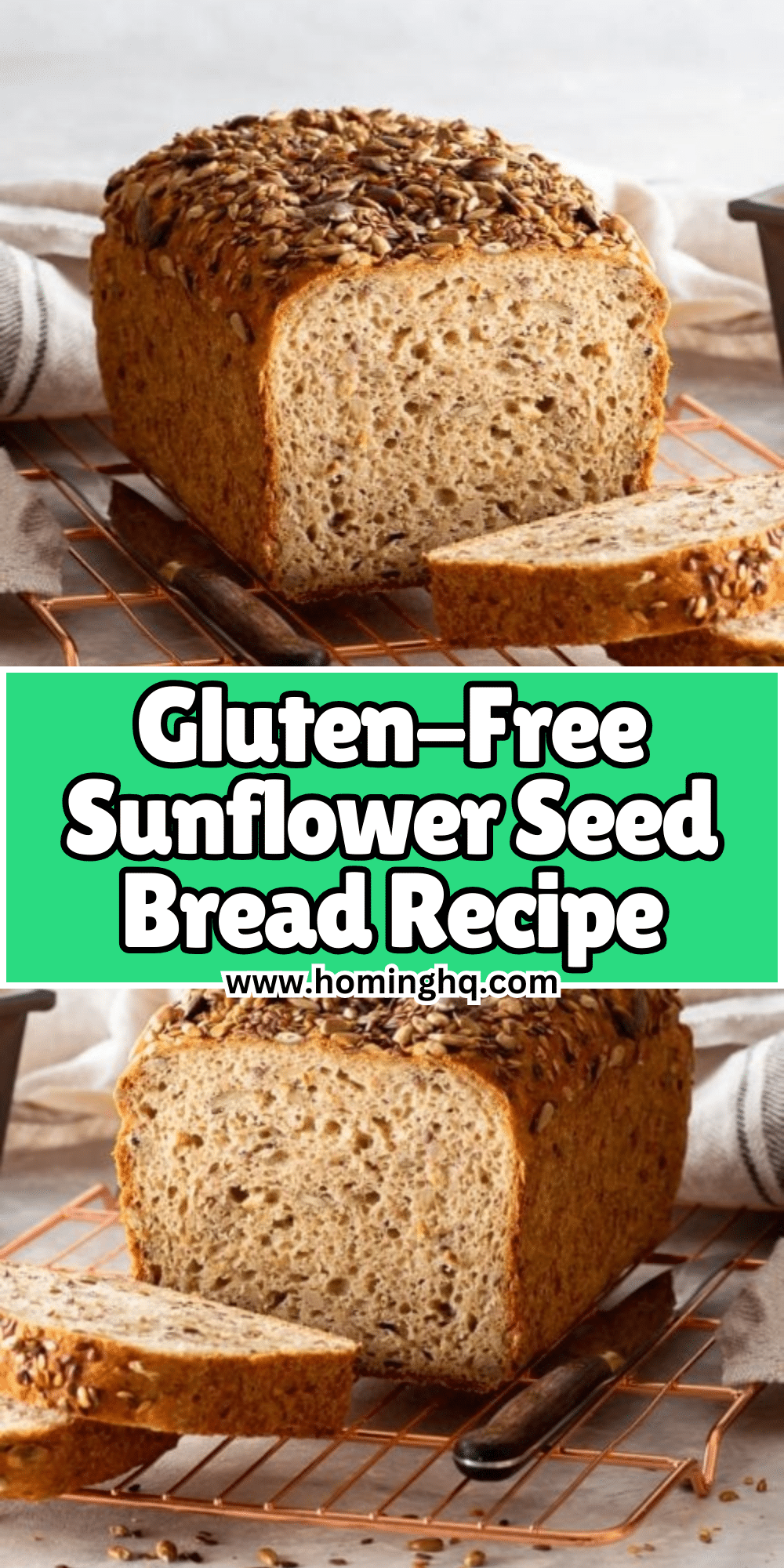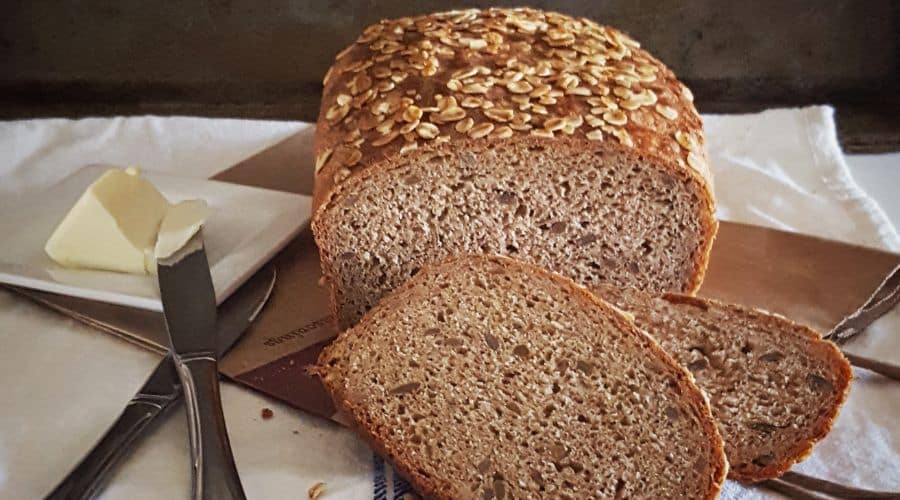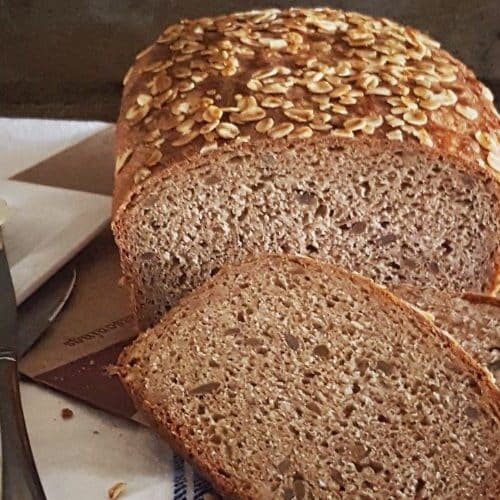All products are selected by our editorial team for quality. If you buy through our links, we may earn a small commission at no extra cost to you.
Baking gluten-free bread can sometimes seem like a challenge, but with the right ingredients and a little practice, anyone can create delicious, satisfying loaves that are free of gluten.
One such loaf is Gluten-Free Sunflower Seed Bread – a hearty, flavorful bread that combines the nutty richness of sunflower seeds with the delicate texture of a gluten-free flour blend.
This bread is not only gluten-free, but it’s also packed with nutrition, providing a great source of protein, healthy fats, and fiber.
Sunflower seeds are a fantastic addition to bread because they offer a subtle crunch and a mild, nutty flavor, making each slice uniquely delicious.
Whether you’re following a gluten-free lifestyle for health reasons or simply exploring new bread options, this recipe will become a staple in your kitchen.
It’s versatile enough for sandwiches, snacks, or simply to enjoy with a warm cup of tea.

Ingredients You’ll Need
Before diving into the preparation, let’s gather all the ingredients for this Gluten-Free Sunflower Seed Bread.
Each ingredient plays a vital role in ensuring the bread comes out perfect every time.
Gluten-Free Flour Blend
The base of this bread is a gluten-free flour blend.
You can either use a pre-made blend or create your own mix of rice flour, potato starch, and tapioca flour.
The flour blend is what provides the structure to the bread, making it light and fluffy without the gluten.
Sunflower Seeds
Sunflower seeds are the star ingredient in this bread.
They add a delightful crunch and nutty flavor, making each bite more interesting.
Plus, they’re a good source of vitamin E, magnesium, and selenium, adding extra nutrition to the bread.
Baking Powder
Baking powder helps the bread rise and become fluffy. Since there’s no gluten to provide structure, the leavening agents are essential for achieving a soft, airy loaf.
Xanthan Gum or Guar Gum
Both xanthan gum and guar gum are commonly used in gluten-free baking to help provide elasticity and structure.
A small amount goes a long way to help the bread hold its shape and prevent it from crumbling.
Salt
A pinch of salt enhances the flavor of the bread and helps balance the sweetness of the other ingredients.
Olive Oil or Butter
Olive oil provides a mild flavor and moisture to the bread, ensuring that it doesn’t turn out dry.
Alternatively, you can use butter for a richer, more indulgent flavor.
Honey or Maple Syrup
A small amount of honey or maple syrup adds a touch of sweetness to the bread, helping to round out the flavor and create a more balanced taste.
Warm Water
Warm water helps activate the yeast and dissolve the other ingredients, giving the dough the perfect consistency.
It’s important that the water is not too hot, as it can kill the yeast.
Active Dry Yeast
Yeast is the key ingredient for helping the bread rise.
It feeds on the sugar in the dough, producing carbon dioxide and causing the dough to expand.
Be sure to activate it with warm water before mixing it into the dough.
Step-by-Step Instructions

Making Gluten-Free Sunflower Seed Bread is simple and rewarding, especially when you follow these step-by-step instructions.
The process will guide you through every stage, ensuring a perfect loaf every time.
Preparing the Dry Ingredients
Start by mixing the dry ingredients together in a large bowl.
In this step, combine your gluten-free flour blend, baking powder, xanthan gum (or guar gum), and salt.
Stir well to ensure that everything is evenly distributed. This will provide a consistent texture throughout the dough and ensure that the bread rises properly.
Preparing the Wet Ingredients
In a separate bowl, combine the warm water, honey (or maple syrup), and olive oil (or butter).
Stir to dissolve the honey or syrup into the water.
Then, add the active dry yeast and allow it to sit for 5-10 minutes. You should see the yeast begin to foam, indicating it’s activated and ready to go.
Mixing the Dough
Once the yeast mixture is ready, pour it into the dry ingredients.
Stir everything together until well combined.
The dough will be slightly sticky, but it should hold its shape.
If the dough seems too dry, add a small amount of water at a time until you reach the right consistency.
Kneading and Shaping the Dough
Though gluten-free dough doesn’t need as much kneading as traditional bread dough, it’s still helpful to gently knead it for about 2-3 minutes to help develop structure.
After kneading, transfer the dough into a lightly greased loaf pan. Use a spatula to smooth the top, ensuring an even surface.
Letting the Dough Rise
Cover the loaf pan with a clean kitchen towel or plastic wrap.
Place it in a warm, draft-free area for about 60-90 minutes, or until the dough has risen and is about double in size.
Since gluten-free dough doesn’t rise as much as regular dough, don’t worry if it doesn’t double completely—it just needs to puff up slightly.
Baking the Bread
Preheat your oven to 350°F (175°C). Once the dough has risen, place the loaf pan in the oven and bake for 40-50 minutes, or until the bread is golden brown on top and sounds hollow when tapped on the bottom.
If the bread starts to brown too quickly, you can cover it with foil and continue baking until done.
Cooling the Bread
Once baked, remove the bread from the oven and let it cool in the pan for about 10 minutes.
Then, transfer it to a wire rack to cool completely. This will help the bread set and prevent it from being too soft when sliced.
Tips for Success
To ensure your Gluten-Free Sunflower Seed Bread turns out perfectly, here are some helpful tips:
1. Use Fresh Yeast
Make sure your active dry yeast is fresh.
If it’s expired, it might not activate properly, which could lead to dense bread.
Always proof the yeast by mixing it with warm water and waiting for it to foam before using it in the dough.
2. Don’t Skip the Xanthan Gum
Xanthan gum (or guar gum) is essential in gluten-free baking.
It helps the dough hold together and gives the bread structure, preventing it from crumbling.
If you don’t have xanthan gum, you can substitute guar gum, though the texture might vary slightly.
3. Monitor Dough Consistency
Gluten-free dough should be slightly sticky but manageable.
If it’s too wet or too dry, adjust by adding small amounts of flour or water.
Remember, gluten-free dough tends to be more delicate than regular bread dough, so handle it gently.
4. Let the Dough Rise Properly
The dough needs time to rise, even though it might not rise as much as traditional bread dough.
Be patient and allow it to rest in a warm environment for the right amount of time. You can also use a warm oven to speed up the process if needed.
5. Use a Thermometer to Check for Doneness
To check if your bread is fully baked, you can use an instant-read thermometer.
The internal temperature of the bread should reach around 200°F (93°C).
This will ensure your bread is baked all the way through without being undercooked or overly dry.
6. Let the Bread Cool Completely
After baking, resist the urge to slice the bread while it’s still warm.
Let it cool on a wire rack for at least 30 minutes to allow the texture to set.
Slicing it too soon could result in a gummy or crumbly texture.
7. Customize the Flavor
Feel free to experiment with additional ingredients like seeds, nuts, or dried fruits for a unique twist on the basic recipe.
Just be sure to adjust the baking time if you’re adding more moisture-heavy ingredients.
By following these tips, you’ll be well on your way to baking the perfect loaf of gluten-free sunflower seed bread every time!
Storage and Preservation
Proper storage is key to maintaining the freshness of your Gluten-Free Sunflower Seed Bread.
Here’s how to keep your loaf at its best:
1. Storing at Room Temperature
Once your bread has cooled completely, you can store it at room temperature for up to 3 days. Place it in an airtight container or wrap it tightly in plastic wrap or foil to keep it from drying out. Store it in a cool, dry area, away from direct sunlight.
2. Freezing the Bread
If you want to keep your bread fresh for longer, freezing is an excellent option. Slice the bread before freezing for easy access to individual pieces. Wrap each slice in plastic wrap or wax paper, and then place all the slices in a zip-top freezer bag.
This way, you can pull out just the amount you need without thawing the entire loaf. Frozen gluten-free bread can last up to 3 months.
To thaw, simply remove the bread from the freezer and allow it to come to room temperature, or toast it directly from frozen for a warm, crispy texture.
3. Refreshing Stale Bread
If your bread becomes a bit stale, don’t throw it away! To revive it, simply wrap it in a damp paper towel and microwave it for 20-30 seconds.
Alternatively, you can warm it in the oven at 350°F (175°C) for about 10 minutes to bring back some of its original texture.
Conclusion
In conclusion, this Gluten-Free Sunflower Seed Bread is a delicious, nutritious option for anyone avoiding gluten.
With its nutty flavor, hearty texture, and versatility, it’s a fantastic addition to your baking repertoire.
Whether you’re enjoying it as part of a sandwich, toasted with some butter, or paired with a warm bowl of soup, this bread will undoubtedly become a favorite.
By following the simple steps and tips provided, you’ll be able to bake a loaf of bread that’s not only gluten-free but also rich in flavor and texture.
Enjoy the process, and don’t be afraid to get creative with the ingredients or toppings.
Happy baking!
Frequently Asked Questions (FAQs)
1. Can I make this bread without sunflower seeds?
Yes, you can!
If you prefer a different type of seed or nut, feel free to swap sunflower seeds for pumpkin seeds, chia seeds, or even chopped walnuts.
Just ensure that the total amount of added ingredients stays the same.
2. Can I use a different flour blend for this recipe?
Absolutely! You can experiment with different gluten-free flour blends, but keep in mind that the texture may vary.
Some blends might require slight adjustments in the amount of liquid used, so be sure to add water gradually until the dough reaches the right consistency.
3. Why is my gluten-free bread dense?
There could be several reasons for dense gluten-free bread.
Most commonly, it’s either the yeast wasn’t activated properly, the dough wasn’t allowed to rise enough, or the wrong flour blend was used.
Be sure to let the dough rise fully, and make sure your yeast is fresh and active.
4. Can I make this bread without using yeast?
Yes, you can make a no-yeast version of this bread by replacing the yeast with baking soda or baking powder.
However, the texture and flavor will be slightly different.
Yeast gives bread a light, airy texture, so using only baking soda or powder will result in a denser, quicker bread.
5. How can I make the bread sweeter?
If you prefer a sweeter loaf, you can increase the amount of honey or maple syrup in the recipe.
Additionally, adding ingredients like cinnamon, raisins, or dried fruit will provide a naturally sweet flavor.
Just be mindful that too much sweetness can affect the bread’s texture, so increase it gradually.

Gluten-Free Sunflower Seed Bread
Equipment
- 1 Loaf Pan (8 x 4 inches)
- 1 Mixing Bowl (for dry ingredients)
- 1 Mixing Bowl (for wet ingredients)
- 1 whisk
- 1 Spatula (for shaping dough)
- 1 measuring cup
- 1 Instant-Read Thermometer (optional, for checking doneness)
- 1 Kitchen Towel (for covering dough while it rises)
Ingredients
- 2 cups Gluten-Free Flour Blend
- 1/2 cup Sunflower Seeds
- 2 tsp Baking Powder
- 1 tsp Xanthan Gum or Guar Gum
- 1 tsp Salt
- 1/4 cup Olive Oil or Butter
- 2 tbsp Honey or Maple Syrup
- 1 1/2 cups Warm Water
- 2 tsp Active Dry Yeast
Instructions
Prepare the Dry Ingredients
- In a large mixing bowl, combine the gluten-free flour blend, baking powder, xanthan gum, and salt. Stir well to ensure everything is evenly distributed.
Prepare the Wet Ingredients
- In a separate bowl, mix the warm water, honey (or maple syrup), and olive oil (or butter).Add the active dry yeast and let it sit for 5-10 minutes until it foams, indicating it’s activated.
Mix the Dough
- Pour the yeast mixture into the dry ingredients. Stir to combine, ensuring there are no dry pockets. The dough should be slightly sticky but manageable. If it’s too dry, add a bit more water, one tablespoon at a time.
Knead and Shape the Dough
- Gently knead the dough for 2-3 minutes to develop some structure. Transfer the dough into a lightly greased loaf pan and smooth the top with a spatula.
Let the Dough Rise
- Cover the loaf pan with a kitchen towel and let the dough rise in a warm, draft-free place for 60-90 minutes, or until it’s slightly puffed up.
Preheat the Oven
- Preheat your oven to 350°F (175°C). Once the dough has risen, place the loaf pan in the oven and bake for 40-50 minutes, until the bread is golden brown and sounds hollow when tapped on the bottom.
Cool the Bread
- Remove the bread from the oven and let it cool in the pan for about 10 minutes. Then, transfer it to a wire rack to cool completely.
Notes
- Flour Substitutes: If you don’t have a pre-made gluten-free flour blend, you can make your own using a combination of rice flour, potato starch, and tapioca flour.
- Sunflower Seed Variations: Feel free to substitute sunflower seeds with other seeds like pumpkin, chia, or sesame, depending on your preference.
- No Yeast Option: For a quicker version, you can replace the yeast with baking soda or baking powder, but note that the texture will be different.
- Storage: This bread stays fresh for up to 3 days at room temperature or can be frozen for up to 3 months. Slice before freezing for easy serving.

